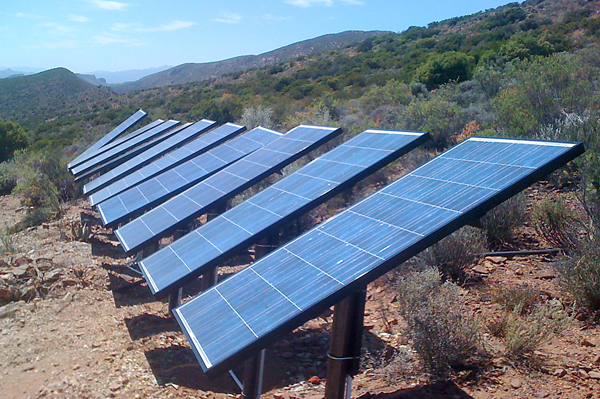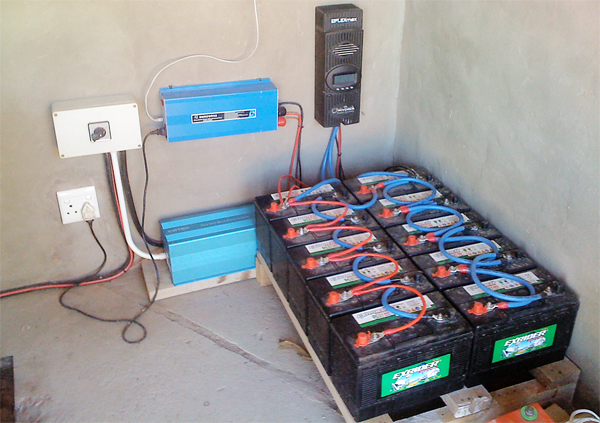Business Maverick
FROM OUR ARCHIVES: A message to Eskom: Screw you!

Here is the good news: it is possible to screw Eskom... sort of. And here is the bad news: you have to change your life. And you have to fork out a whack of cash.
I should say at the outset that this is my personal story. It is also an incomplete story, because I have just started on the journey and it’s not clear yet whether it’s sustainable over the long term or whether all the equipment will last.
‘How to screw Eskom’ is the practical story worth telling because when I started living it, the real world solutions were few and far between. They generally fell into two flavours: American isolationists in the Midwest or Californian greenies, neither of which are very much applicable to South Africa. It gets worse when you establish what is actually available here and made for local conditions. But for those of you interested in living life in a more environmentally friendly and independent way, or just interested in saving money in the long term, these are my experiences so far, for what they are worth.
Living sustainably, I have to admit, was a concept more or less forced on my wife and me, since we decided to try to live in a fairly remote spot in the Karoo. (It also happens to be one of the most mind-blowingly beautiful spots – Ed). Getting Eskom power installed to the house we decided to build, about 5km from the nearest Eskom line was an option. The cheapest quote we could get was around R250 000 and this was some time ago. Weirdly, the biggest part of the madly expensive quote was digging the deep holes necessary to hold the long poles required for electricity lines.
With Eskom, thankfully, out of picture, sustainable, renewable energy was the only way we could go. But all the options were slightly bewildering and involved making a set of choices with little guidance. The whole thing also involved a whole new acronym soup made out of intricate electrical things which I only remotely remember from school – volts, amps, kilowatts and connections in parallel and in series. Even before that, the first big choice was between wind power and solar power. I experimented with both and found there to be fairly obvious downsides to both.
Wind generators are difficult to find in SA. Eventually, I found something called a Wind-X generator which is sold by company called KG Electric in Randpark Ridge. The generators are US-made, using technology that is getting increasingly sophisticated.
One of the biggest problems with wind power is consistent output, because wind speeds vary so wildly. In a strong wind area, like the Karoo, wind speeds can zoom up, and most devices can’t handle that for a sustained period as the internal mechanisms just wear out too fast.
But the Wind-X has a “top-speed cut-off”, which means that on very windy days, it stops and then immediately restarts, which doesn’t allow the system to run itself into apoplectic destruction. One turbine costs about R9,000. We have had one operating now for three years on a cottage we built in preparation for moving in permanently, and it’s worked extremely well. But there is one big downside to the damn thing: it howls, big time. The idea is to get the propellers up as high as possible because the higher you go, the stronger the winds. However, it also means that wind travelling around the pole, (a thick metal thing, which you have to buy separately), “woos” like the proverbial ghost, while the propeller itself swishes like a high-octane swordfight. Some people are not put off by the sound, but I am. It simply destroys the silent solace of the Karoo.
By comparison, photovoltaic panels are a pleasure. Of course, they have downsides too, but more about that later. The best thing about them is that, unlike wind systems, panels have been coming down in price quite dramatically as they are being used more and more by cellphone networks with unit costs declining from large orders from rich companies. When I started looking at solar panels, they were difficult to get hold of and cost about R10,000 each for a 30W system. Now you can get – and hold onto your hat for the technospeak – a 65W, polycrystalline, glass laminate on an anodised aluminium frame, photovoltaic 12volt system for R6,000 a pop.
Which brings me to the difficult issue of voltage. The general rule seems to be that the higher the voltage the better, because – as you might remember from school – when you are moving electricity around, the higher the voltage, the more efficient it is. It also makes the conversion to 220v more efficient too. This is no small thing; you generally lose about 10% of your power in conversion.
At first we thought of trying to make our whole lighting system run on 12v, but it turned out to be impractical. There is really only one kind of 12v light, and it’s a horrible, small neon thing designed mainly for caravans. On the other hand, 220v neon lights are now fairly freely available in both screw-in and bayonet form and all shapes and sizes. The warm-light systems are fine even for people who generally hate neon lights. The coloured lights look just great and are well worth experimenting with.
Ultimately, on the advice of the retailer, in my case an outfit called PlanMyPower in Randburg, we decided to go for a 24v system, which is easier to deal with than a 48v system, but slightly more efficient that the 12v system.
The next thing you need is a whole bunch of batteries, and not just any battery. You need something called deep-cycle batteries which cost about R1,000 each. Of course, this is not the end of the story. Next thing you’ll need is something called a “Maximum Power Point Tracking” device or MPPT. The device regulates the voltage output from the solar panels, which is much more important than it seems. Batteries can’t accept more than 14v and solar panels, at their high points during the day, pump out much more than this and their output cannot be regulated. The MPPT solution is to convert the excess volts into amps (remember science class? Volts x amps = watts) and, thereby, capture the excess supply. The MPPT system I bought is the Australian Flexmax 80 model, made by people inevitably called Outback.
The downside of solar systems is obvious: they need the sun, and the more of it the better. Out in the Karoo, they work like a charm, but in Joburg, there may be days or even weeks, when you just won’t get any power. Most people recommend a mixed wind and solar system, which is easy to do, because you just connect them at the battery pack.
You also need backup. Sadly, because both solar and wind are weather dependent, to be able to ensure your wife (or yourself) can use the hairdryer any time, a non-negotiable in most households, you have to have a backup system. That means a generator.
Buying the backup is where I made my costliest mistake. Being a mensch, I bought a huge generator, a 50kW three-phase diesel generator, which could power the average town. I did so partly because I got a good price, R50,000, but partly because a big motor is just irresistible. It is the isolationists’ version of a sports car.
Anyway, as it turns out, you don’t need anything like that, and for a normal household, a R10,000 diesel generator would be perfectly adequate (although, obviously, people with huge 50kW three-phase diesel generators, will look down on you.)
Okay, that was all nice, but now for the bad news. The saddest discovery you make early in seeking out solar and wind power is that neither is very powerful. The technology is just not quite there yet. If you think about it, this is pretty obvious. There is a reason we have huge coal power plants – because they can generate huge amounts of power efficiently, Eskom notwithstanding. For all the sun’s great power, hold out your hand in the sun for a while, and all you feel is a slight tingle. That is what you are trying to trap.
As a result you need a lot of panels, and the more the better. I bought 10 24v, 120W panels and with the MPPT, the wiring, a 24v-to-220v converter, the crucial attachments to set the panels at the right angle, 12 12v deep-cycle batteries and a really good battery generator. The whole thing set me back just under R100,000. Paying that took a real gulp.

Photo: A really good solar pannel array. (Photo: Tim Cohen)
For that, the solar system is paid off in less than two years. So, does it work? So far, brilliantly.
The MPPT has a very natty system for keeping track of the power you generate, so I know it is generating around 7kW/h a day. That’s 210kW/h a month. This is enough to run a computer for the whole day, a fridge, a freezer, do a few loads of laundry and pump the water and keep the lights on. The problem is that this may be adequate, but it is not urban life. My September bill for a house in Parkhurst in Johannesburg involved using 148.1kW/h a day, or 4,304 kW/h for the month.
In other words, for R100,000 our solar system is generating only about one-twentieth of the power we typically used in a two-person house.
On the other hand, if you put the capital cost aside for a moment, there are no monthly costs that stretch on into infinity, and keep rising as Eskom mismanages our electric system. That 4,304kW/h usage cost R2,789 a month, before the Eskom increases. Three 45% increases, which Eskom has asked for, could treble this bill to about R8,300 a month. We assume, they won’t get that, but still work on the basis of a R5,000 a month average bill.

Photo: The heart of the system, with 12 12v deep-cycle batteries, and Outback MPPT above them. (Photo: Tim Cohen)
Obviously, however, the power we need here is but a fraction of what we were using in Johannesburg. My wife and I designed our house knowing we would have to work with less, so the geysers, stove and oven are gas, which you obviously have to factor into the overall cost. Using gas is, however, cheap and efficient, because you only use as much power as you need at that time. There are great new gas geysers from Rinnai, also Australian made, which regulate the output temperature very accurately and are a huge step up from the horrible systems we used to get at Parks Board camping sites.
Reconfiguring your electrical system can make you seem like an isolationist nut or an impractical, new-age dreamer. But there is a larger issue at stake here. Just as the internet allows individuals to bypass the mandarins of the publishing process, improving technology is allowing self-reliance in other areas. After all, one of the best ways to ensure publishers publish the right stuff, for example, is to do it yourself. Similarly, the way to keep Eskom responsive and responsible is to seek out alternatives – especially environmentally friendly ones.
Our house is a modest thing on a hill in the desert. It’s not going to bring Eskom down and they will probably not miss my R2,789 a month. But it stands, to my hyper-impressionistic sensibilities anyway, as a mighty monument to alternatives.
And by the way, the next time there is a power cut, my commiserations. Honest. DM
Read more: KG Electric
Main photo: Karoo, the beautiful. No power lines here.

















 Become an Insider
Become an Insider